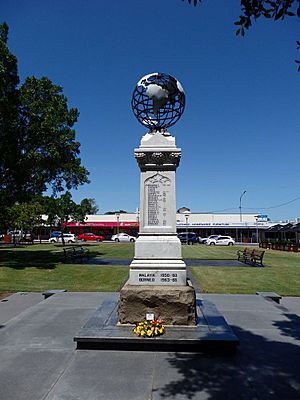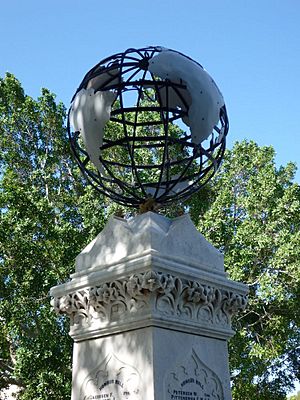Pialba Memorial Cenotaph facts for kids
Quick facts for kids Pialba Memorial Cenotaph |
|
|---|---|

West side of the cenotaph
|
|
| Location | Freedom Park, Main Street, Pialba, Fraser Coast Region, Queensland, Australia |
| Design period | 1919-1930s Interwar period |
| Built | 1918–1921 |
| Architect | Philip Oliver Ellard Hawkes |
| Architectural style(s) | Classicism |
| Official name: Pialba Memorial Cenotaph | |
| Type | state heritage |
| Designated | 6 May 2016 |
| Reference no. | 650026 |
| Type | Monuments and memorials: Memorial/monument |
| Theme | Creating social and cultural institutions: Commemorating significant events |
| Builders | Frederick William Webb |
| Lua error in Module:Location_map at line 420: attempt to index field 'wikibase' (a nil value). | |
The Pialba Memorial Cenotaph is a special historical monument located in Freedom Park, Pialba. Pialba is a suburb in Hervey Bay, Queensland, Australia. This memorial was designed by Philip Oliver Ellard Hawkes and built between 1918 and 1921. It was officially added to the Queensland Heritage Register on 6 May 2016. People also know it as the Pialba War Memorial or the Hervey Bay War Memorial.
History of the Cenotaph
The Pialba Memorial Cenotaph was officially shown to the public on Sunday, 17 July 1921. It was built to honor the local men who went to fight in World War I (WWI) and especially those who died.
Where the Cenotaph Started
The cenotaph was first placed near a railway area, west of Main Street. In the late 1990s, the marble pillar was moved about 30 meters west. It now stands in its current spot in Freedom Park. This park has paths, grass, and trees. The Pialba Memorial Cenotaph is important because it shows Queensland's part in a big world event. It is a key place for ANZAC Day ceremonies and is highly valued by the Hervey Bay community.
Pialba's Early Days
Pialba is now part of Hervey Bay. European settlers first came to Hervey Bay in the mid-1850s. They started large farms for animals. People also began cutting down trees for wood in the mid-1860s.
Farms in the Pialba area grew fruit, corn, and potatoes. But these farms didn't do well until a railway line opened in 1896. This railway connected Pialba to Colton railway station. The railway helped transport farm products. It also brought people for fun train trips and picnics from places like Bundaberg and Maryborough. By 1905, Pialba was a popular holiday spot by the water.
World War I and Memorials
World War I was fought from 1914 to 1918. Like all Australian towns, Pialba was greatly affected. Many Australians went to fight overseas. Sadly, many died or were wounded.
Even before the war ended, communities across Australia started building memorials. These memorials honored local people who had served and died. They were a way for the nation to show its sadness. They also served as substitute graves for those whose bodies remained in battlefields far away.
People in communities raised money for these memorials themselves. The government did not usually give money for local WWI memorials.
Types of War Memorials
War memorials in Australia came in many forms. Some were honor boards, which listed names. Others were stone monuments like tall pillars (obelisks), soldier statues, or arches. Some communities planted memorial avenues of trees or created memorial parks. Some built useful structures like gates or halls. In Queensland, statues of soldiers were very popular.
People often debated if a war memorial should just be a statue or have a useful purpose. After WWI, most Australian towns chose a monument. Only a few chose useful buildings like memorial halls. After World War II, useful memorials became more popular.
Building the Pialba Memorial
Pialba decided to build a monument for its war memorial. In 1918, local leaders asked for a good spot for a memorial "for fallen soldiers." They were given a site in Station Square. This area was between the Pialba railway station building and Main Street. This location was fitting because many soldiers would have left from the railway station.
Local people raised over £200 for the memorial. The foundation stone was laid on 14 December 1918. However, the white marble for the monument's pillar was delayed. So, the finished memorial was not officially shown until 17 July 1921. Frank William Webb from Maryborough was the builder. The architect was POE Hawkes. Hawkes also designed the Maryborough War Memorial.
What the Monument Looks Like
The final design of the monument included a fence around it. An old photo from 1950 shows this fence. The base of the marble pillar has words carved into it. It says the stone was put up by the people of Pialba to honor the men who served and died in the Great War. One side lists the names of those who died. The other three sides list the names of men who served.
Later, the names of other wars were added to the base of the pillar. These include World War II, the Korean War, the Malaya and Borneo conflicts, and the Vietnam War.
At the unveiling ceremony, it was said that 120 men from the area went overseas, and 18 died. However, the monument now lists 112 men, with 22 who died. A German machine gun was also given to Pialba as a war trophy.
Changes Around the Cenotaph
In 1941, the old Pialba Shire Hall was moved near the cenotaph. The RSSAILA used it as a memorial hall.
The land around the cenotaph has changed over time. The last passenger train service to Pialba station was in 1972. Train services stopped completely in 1994. By late 1998, the cenotaph was moved 30 meters west. The area became part of Freedom Park. The railway station building was also moved and turned around to face the cenotaph. The cenotaph was rededicated on 6 January 1999. A metal globe with laurel leaves was added to the top of the marble pillar at this time.
Other memorials have been added to Freedom Park. A memorial for National Servicemen was placed north of the cenotaph in 2003. A Light Horse statue was added in 2014. The cenotaph is still the main focus for memorial ceremonies.
Description of the Cenotaph
The Pialba Memorial Cenotaph is in Freedom Park. This park is at the corner of Main Street and Charles Street in Pialba. The park has grassy areas, large trees, and other modern memorial structures.
Only the cenotaph itself is considered a state heritage site. The memorial hall is important for local history.
The Memorial Cenotaph
The Pialba Memorial Cenotaph is at the south end of Freedom Park. It is placed where modern paths from Main Street and Charles Street meet. The memorial has a fancy white marble pedestal on a light-brown stone base. It sits on a dark granite platform with steps.
The stone base is square and has rough sides. The pedestal has carved sections and decorative metal panels. These panels list 22 men from the area who died in WWI. They also list 90 men who served. The top part of the pedestal has carved lilies and leaves. A metal globe, showing the continents, has been placed on top of the monument.
Words at the bottom of the pedestal remember other major conflicts:
- SECOND WORLD WAR 1939-45 (east side)
- KOREAN WAR 1950-53 (south side)
- MALAYSIA 1950-60 and BORNEO 1963-66 (west side)
- VIETNAM WAR 1962-72 (north side)
The east side of the monument also has this carved message:
"THIS STONE WAS ERECTED BY THE CITIZENS OF PIALBA & DISTRICT IN HONOUR OF THE MEN WHO SERVED AND FELL IN THE GREAT WAR. 1914-1919."
The modern granite platform, the metal globe, and the concrete paths are not part of the heritage listing.
Why the Cenotaph is Important
The Pialba Memorial Cenotaph was added to the Queensland Heritage Register on 6 May 2016. It meets several important criteria.
Showing History
The Pialba Memorial Cenotaph, officially shown in 1921, is important for showing Queensland's part in a major world event. World War I memorials honor those who served and died from a community. They are a key part of Queensland's towns and cities. They also show a common way of remembering across Queensland and Australia.
Unique Features
The Pialba Memorial Cenotaph is a great example of a well-designed and beautifully made WWI monument. Local people paid for it. It shows the main features of a WWI memorial. The cenotaph lists the names of those who served and those who died. It represents the empty grave of those from the area who did not return home. Its design includes classic symbols of sympathy and mourning.
Community Connection
The Pialba Memorial Cenotaph was paid for by local people. It has a strong and special connection with the people of Hervey Bay. The ceremonies held at the cenotaph show the deep respect people have for war memorials across Australia. As a main place for ANZAC Day ceremonies, the community highly values the cenotaph for its spiritual, symbolic, cultural, and social importance.



